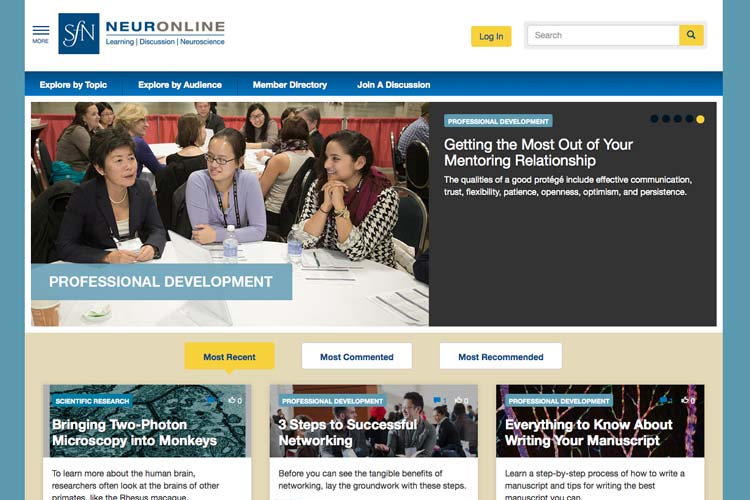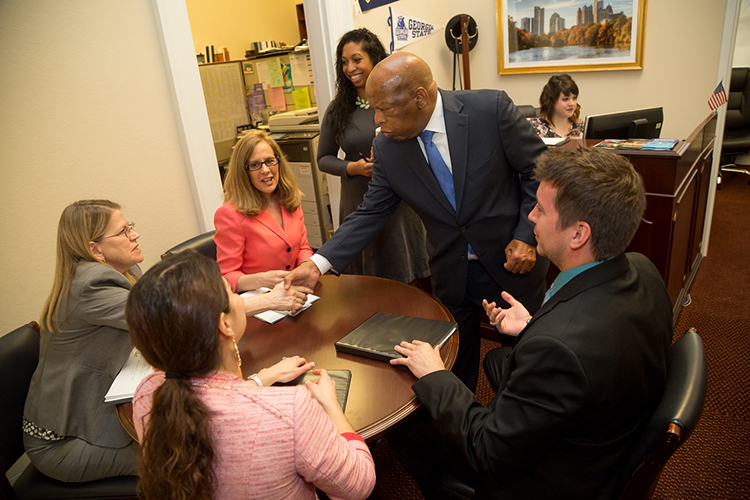
Neuroscience 2015 in Review
Each year thousands of people in the field of neuroscience look forward to the Society for Neuroscience’s annual meeting, and 2015 was no different. In mid-October, more than 29,000 neuroscience researchers, clinicians, and advocates traveled to Chicago from 77 countries for Neuroscience 2015, the world’s largest meeting on the brain and nervous system. McCormick Place, the largest convention center in North America, was brimming with neuroscientists attending lectures and symposia, sharing their work, and exploring various professional development and networking opportunities.
This year’s meeting featured nearly 14,000 poster presentations, 25 special and featured lectures, and 49 symposia and minisymposia covering the breadth of the field. In addition to posters and scientific lectures, attendees navigated an expansive Exhibit Hall, where 516 companies displayed and demonstrated lab equipment and new neuroscience tools and technologies. You can revisit the Exhibit Hall online to check out annual meeting products with the My Neuroscience Marketplace virtual directory at SfN.org/exhibithall.
SfN also offered training, mentoring, and professional development activities for neuroscientists at every stage of their career. For example, attendees had the opportunity to talk with respected neuroscientists about their research techniques and accomplishments during the Meet-the-Expert Series, and the popular Careers Beyond the Bench workshop helped neuroscientists explore career trajectories outside of academia.
Hundreds of neuroscientists also took advantage of full-day training opportunities such as the Neurobiology of Disease Workshop, which focused on brain malformations, particularly those affecting the cerebral cortex, and how they are common causes of intellectual disability and epilepsy.
Presidential Special Lectures
“We are scientists, and scientists like to play,” 2014 Nobel Laureate May-Britt Moser, PhD, told a packed venue at the Society for Neuroscience’s 45th annual meeting. Moser, who was among four Presidential Special Lecturers, emphasized the joy of science as she shared her discoveries on how the brain maps and navigates environments through a network of “grid” cells in the brain.
Having acknowledged that as a scientist she is drawn to science where there is very little known, 2015 MacArthur Fellow Beth A. Stevens, PhD, discussed her research on microglia’s role in mental health. Her lecture, “Immune Mechanisms of Synapse Loss in Health and Disease,” explored how synaptic pruning can result in both disease prevention and creation.
2013 Nobel Laureate Thomas Südhof, MD, and Cori Bargmann, PhD, also delivered Presidential Special Lectures. Südhof’s lecture, “The Molecular Logic of Neural Circuits: Implications for Autism and Schizophrenia,” presented a conceptual framework for understanding neural circuits in health and disease. In her lecture, titled “Themes and Variations in Circuits and Behavior,” Bargmann discussed how neurons, circuits, and the environment drive flexible behaviors like foraging.
Dialogues Lecture: ‘Neuroscience and the Law: Strange Bedfellows’
During the annual Dialogues Between Neuroscience and Society lecture, Senior U.S. District Court Judge Jed S. Rakoff of the Southern District of New York discussed the legal and ethical questions raised as neuroscience enters the courtroom and affects the judicial system.
“Neuroscience has advanced to the point where it can make generalizations that will be, and are, important to the legal system in determining overall approaches and policy,” Rakoff said.
“I hope that [neuroscientists] will see that they have a responsibility to promote good neuroscience and affect public policy because it has great implications for the development of society,” he added.
Watch the complete Dialogues lecture at SfN.org/dialogues.
Special Presentation: ‘Understanding an Era of Unprecedented Advances in Neuroscience’
In a special presentation, NIH Director Francis Collins discussed the role of initiatives such as the Brain Research through Advancing Innovative Neurotechnologies (BRAIN) Initiative and the Human Connectome Project. He also stressed the importance of developing new technologies that can move the field forward and collaborations that can stimulate new ideas.
Collins noted that there is a direct correlation between funding and scientific research success rates, and he encouraged the audience to spread the word about the importance of science funding.
“One thing I’ve learned is that if you really want to have an effect, a single voice is a good thing, but a symphony is a whole lot better,” Collins said.
Watch Collins’ complete lecture at SfN.org/specialpresentation.
Taking the Conversation Online
Keep the conversation and collaboration going on Neuronline, SfN’s members-only home for learning and discussion. Neuronline is posting a variety of Neuroscience 2015 content, including videos of professional development workshops, articles about annual meeting short courses, and many other tools and resources. Not an SfN member? Join today to access Neuronline.
You can also check out the early buzz about Neuroscience 2016, taking place November 12-16 in San Diego, by visiting SfN on Twitter at @SfNtweets and using the hashtag #SfN16.



















